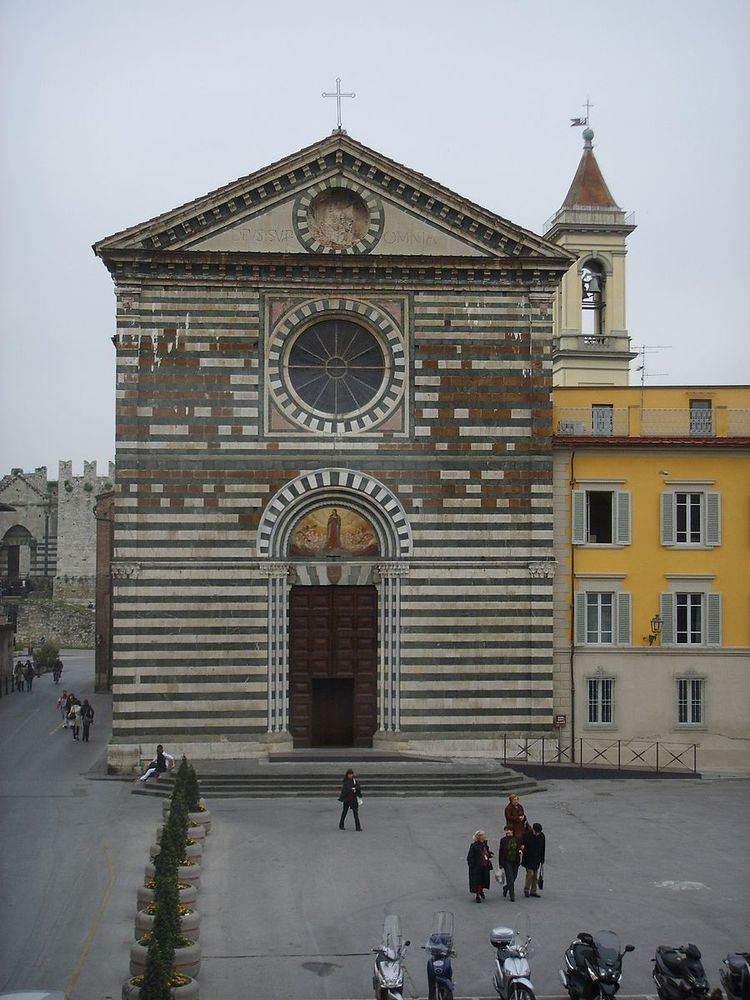Location Prato, Italy Groundbreaking 1281 Length 65 metres (213 ft) Province Province of Prato Year consecrated 1508 | Architectural type Church Completed 1331 Opened 1331 Phone +39 0574 31555 Affiliation Catholic Church | |
 | ||
Address Piazza S. Francesco 10, 59100 Prato PO, Italy Architectural styles Gothic architecture, Romanesque architecture Similar Cappella Migliorati, Palazzo Datini, Santa Maria delle Carceri - P, San Domenico - Prato, Castello dell'Imperatore | ||
Appartamento in affitto san francesco al prato perugia porta s susanna porta sole porta s
San Francesco is a church in Prato, Tuscany, central Italy. San Francesco’s church, in the homonym square (XII–XIV sec.), it is located in the nucleus of the Oldest City of Prato and an Important Place of Catholic worship and one of the first Franciscan Churches with his big convent built on the ground that was donated by the municipality to the friars minor only eight days after the canonization of the saint, in 1228.
Contents
- Appartamento in affitto san francesco al prato perugia porta s susanna porta sole porta s
- History and architecture
- Internal Architecture
- The Cloister
- Miglioratis Chapel
- References
History and architecture
The edifice was begun in 1281, next to an oratory of the Franciscan convent, which had been built in 1228. It was finished in 1331, the first building in Prato built in brickwork instead of stone. The façade is divided in bichrome stripes in alberese and serpentinite with a central portal, and ends with a 15th-century triangular tympanum with a stucco frieze by Andrea Della Robbia, depicting the Stigmata of St. Francis. The 18th-century bell-tower was designed by Antonio Benini (1799-1801).
Internal Architecture
The large interior was restored to a neo-medieval state in 1902–04.
Among the arworks are the funerary monument of Geminiano Inghirami (c. 1460), attributed to Pasquino da Montepulciano (and stylistically similar to Antonio Rossellino), who also executed the small cyborium on the presbytery wall.
Next to a Renaissance pulpit in pietra serena is a 15th-century panel with Christ's Monogram, which is traditionally considered to have been brought to Prato by San Bernardino; above the high altar is a 14th-century polychrome wooden Crucifix, donated by the merchant Francesco Datini (who was buried next to the altar). The latter's tomb in white marble (work of Niccolò di Pietro Lamberti, 1411–12) portrays him within an elaborated Gothic tabernacle.
Regnadori's Chapel
The door below the choir, on the left of the presbytery, we can enter into the Chapel Regnadori, protruding from the side of the church. Realized in the first half of the fourteenth century, it is covered by two cross vault with ribs; the wall to the left of the entrance is decorated with a cornice in pietra serena late renaissance, with arch on fluted pilasters, with that, we can access to another chapel coeval (of employers Spighi) demolished in 1903. The wall in front of the entrance retains traces of frescoes seventeenth century ; and on the semipilaster is carved out the family crest fourteenth Regnadori ( From which chapel takes this name ) . A Right surmounted by a lancet window and there while the neo-Gothic altar ciborium is the Same that adorn one time an altar. Side of the altar there are niches with statues had : on the left a “Ecce Homo” century in colored wax, opposite a sorrow rifined.
The Cloister
The cloister, dating to 1438–1440 and featuring Ionic columns, is the first Renaissance architectural work in the city. It has several coat of arms from the 15th-19th centuries, and several frescoes: a lunette with the Madonna and Child and a tabernacle with the Madonna Enthroned and Saints from the early 14th century.
Migliorati's Chapel
The Chapter (or Migliorati's Chapel) was entirely frescoed around 1400 by Niccolò Gerini, with figures inspired by Giotto. The scenes include a ruined Cricifixion, the Stories of St. Matthew and Stories of St. Anthony (the latter also damaged) and, on the vault, the Evangelists.
